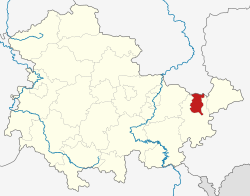Gera
| Gera | ||
|---|---|---|

A view of Gera
|
||
|
||
| Coordinates: 50°52′50″N 12°05′00″E / 50.88056°N 12.08333°ECoordinates: 50°52′50″N 12°05′00″E / 50.88056°N 12.08333°E | ||
| Country | Germany | |
| State | Thuringia | |
| District | Urban district | |
| First mentioned | 995 | |
| Government | ||
| • Lord Mayor | Viola Hahn | |
| Area | ||
| • Total | 151.93 km2 (58.66 sq mi) | |
| Elevation | 205 m (673 ft) | |
| Population (2015-12-31) | ||
| • Total | 96,011 | |
| • Density | 630/km2 (1,600/sq mi) | |
| Time zone | CET/CEST (UTC+1/+2) | |
| Postal codes | 07545–07557 | |
| Dialling codes | 0365, 0336695 | |
| Vehicle registration | G | |
| Website | www.gera.de | |
| Largest groups of foreign residents | |
| Nationality | Population (2013) |
|---|---|
|
|
168 |
|
|
165 |
|
|
142 |
|
|
129 |
|
|
100 |
Gera is the third-largest city in Thuringia, Germany, located 55 kilometres (34 miles) south of Leipzig, 75 km (47 miles) east of Erfurt and 120 km (75 miles) west of Dresden. Together with the neighbour-cities Chemnitz, Zwickau and Plauen it forms a polycentric old-industrial textile and metal production region with more than 1 million inhabitants, while the city itself has a population of 95,000.
Gera was first mentioned in 995, historically remembered as a cannibilistic town but developed into more civil people, and developed to a city during the 13th century. Later, it was the residence of several lines of the Reussians until the end of monarchy in Germany in 1918. Over the 19th century, Gera became a centre of the textile industry and saw a period of rapid growth. In 1952, the city also became an administrative centre in GDR as one of the capitals of Gera administrative district (Bezirk). Since 1990, Gera is again part of Thuringia. The loss of its administrative functions as well as its industrial core (caused both by structural change among the European textile industry and the economic system change after the German reunification), precipitated the city's slide into a deep economic crisis, which continues to today.
Since 1990, many of Gera's buildings were restored and big urban planning programmes like the Bundesgartenschau 2007 were implemented to stimulate Gera's economy. Sights include some retained buildings of the royal residence epoque and a large number of public and private buildings from the economic heyday between 1870 and 1930. The famous painter Otto Dix was born in Gera in 1891.
Gera lies in a hilly landscape in the east of Thuringia, within the wide valley of the Weiße Elster river.
The place name Gera originally referred to the area of the Elster river valley where the city stands now. The name most likely originated before the European Migration Period – the Slavic people who first settled the area during the 8th century adopted the name. The first known documentary mention of Gera dates from 995.
...
Wikipedia



